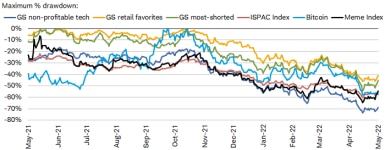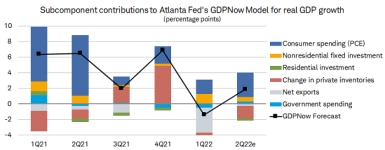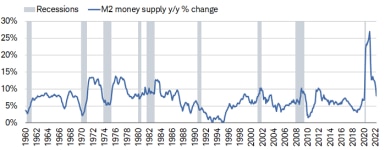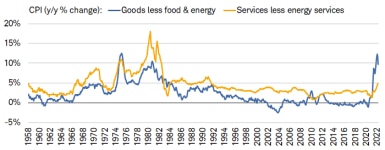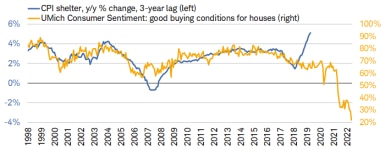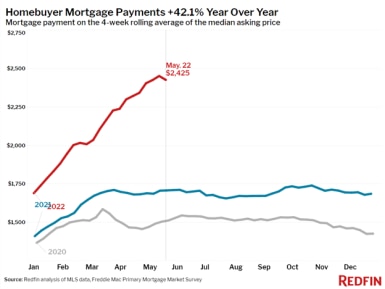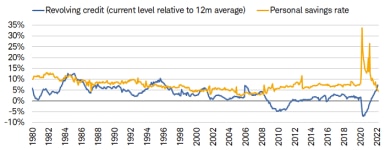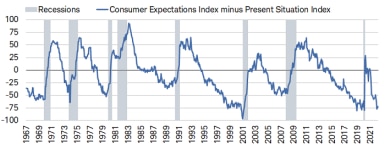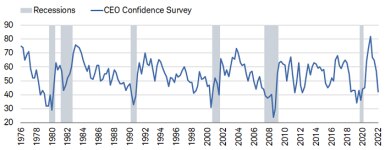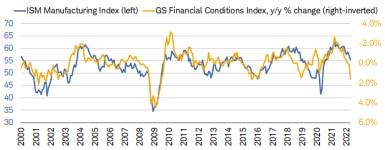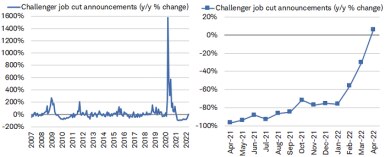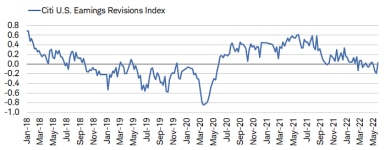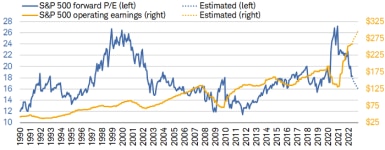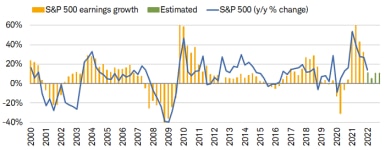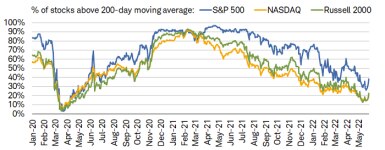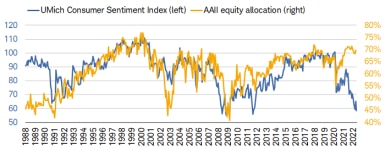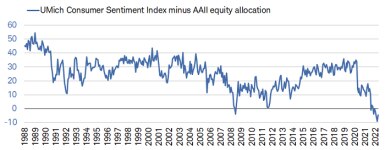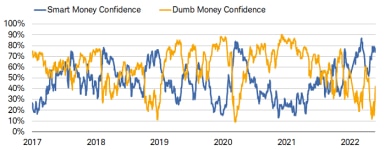2022 Mid-Year Outlook: U.S. Stocks and Economy

Toward the end of last year, as usual, we penned our 2022 outlook and the vast majority of our expectations panned out. Those included:
- Consumers' strength and confidence being tested by inflation (especially on the goods side of the economy)
- Rise in labor force participation
- Rolling over in profit margins
- Federal Reserve's tapering to pick up speed
- Carnage in narratives-driven and speculation-hyped market segments
- Earnings becoming "less hot"
- Quality-oriented factors will be relative outperformers
- Households' elevated equity exposure bodes ill for equity performance
- Elevated optimistic sentiment to act as a contrarian signal
- Indexes to "catch down" to 2021's under-the-surface weakness
- Higher intra-market correlations and greater tail risks
Let's start with a quick update on market weakness so far in 2022. Unlike last year—when index declines were muted, but churn/weakness under the surface was more pronounced—this year so far has brought much more weakness at the index level (with underlying churn still extreme). This is shown in our crowd-favorite drawdowns table below.
Source: Charles Schwab, Bloomberg, as of 5/27/2022. Indexes are unmanaged, do not incur management fees, costs and expenses and cannot be invested in directly. Past performance is no guarantee of future results. Some members excluded from year-to-date return columns given additions to indices were after January 2022.
In terms of speculation-fueled/narrative-driven market segments, as shown below, drawdowns accelerated this year with a range between -45% and -75% depending on the segment.
Spec areas under pressure
Source: Charles Schwab, Bloomberg, as of 5/27/2022. Goldman Sachs (GS) non-profitable technology basket consists of non-profitable U.S.-listed companies in innovative industries. Technology is defined quite broadly to include new economy companies across GICS industry groupings. Goldman Sachs (GS) retail favorites basket consists of U.S. listed equities that are popularly traded on retail brokerage platforms. Goldman Sachs (GS) most-shorted basket contains the 50 highest short interest names in the Russell 3000; names have a market cap greater than $1 billion. ISPAC Index is a passive rules-based index that tracks the performance of the newly listed Special Purpose Acquisitions Corporations ("SPACs") ex- warrant and initial public offerings derived from SPACs since August 1, 2017. The Meme Index is constructed by Bloomberg and contains 37 stocks that are considered actively traded and/or discussed among day-traders, retail investors, and chatrooms. Individual stocks shown for informational purposes only. Indexes are unmanaged, do not incur management fees, costs and expenses and cannot be invested in directly. Past performance does not guarantee future results.
Although we expect counter-trend rallies could lend some short-term support to these more speculative areas of the market as buyers take a chance on some recovery in speculative juices, we believe the "low quality" trade will not reassert leadership this year. See more about the market later in this report.
Soft or hard landing?
Clearly, a 40-year high in inflation, an aggressive tightening of monetary policy by the Fed, the Russia/Ukraine war, and the slowdown in economic growth have weighed on stocks this year. Real gross domestic product (GDP) growth contracted in the first quarter, while estimates for the second quarter are fairly anemic (albeit positive so far). As shown below, the big drag in the first quarter was net exports, with government spending and inventories also contributing to the weakness. The outlook for the second quarter is for private inventories and net exports to remain a drag, along with residential investment (housing).
Drags from net exports/inventories
Source: Charles Schwab, Federal Reserve Bank of Atlanta, as of 5/27/2022. Forecasts contained herein are for illustrative purposes only, may be based upon proprietary research and are developed through analysis of historical public data.
Much economic debate centers around whether a recession is likely. History's lessons about the impact of Fed rate hike cycles—there were 10 recessions associated with the past 13 rate hike cycles, and only three soft landings—suggest a recession is more likely than a soft landing. When you add into the mix the Russia/Ukraine war, elevated inflation, growth already under pressure and the Fed simultaneously starting to shrink its nearly $9 trillion balance sheet, arguably the needle has moved more toward recession.
No longer spoon(Fed)
Among the most important shifts in the macroeconomic backdrop over the past year has been the receding liquidity tide, courtesy of a double-barreled reduction in monetary and fiscal stimulus. The U.S. economy and asset markets greatly benefited from the epic jolt from trillions of dollars' worth of liquidity doled out by the Federal Reserve and Congress. As such, money supply spiked at a breakneck pace, as shown below.
Liquidity tidal wave
Source: Charles Schwab, Bloomberg, Federal Reserve Bank of St. Louis, as of 4/30/2022. M2 is a measure of the U.S. money stock that includes M1 (currency and coins held by the non-bank public, checkable deposits, and travelers' checks) plus savings deposits (including money market deposit accounts), small time deposits under $100,000, and shares in retail money market mutual funds.
Annual growth in the money supply peaked at 27% in February 2021 and has rolled over significantly, now edging closer to its pre-pandemic rate. In conjunction with a Fed that is now raising rates at a rather aggressive pace (one 25-basis-point and one 50-basis-point hike so far, with another couple of 50-basis-point hikes expected near-term) and starts reducing its balance sheet this month, it is clear that the accommodative phase of the current cycle is well in the rearview mirror.
The chief reason for the Fed's aggressive posture is undoubtedly the hotter inflationary environment. The most acute pressures have come from the goods side of the economy—courtesy of the forced, rapid shift in spending habits during the pandemic and reeling supply chains. Services inflation has also started to move up in a more sustained manner, as shown below.
Passing the baton
Source: Charles Schwab, Bloomberg, Bureau of Labor Statistics, as of 4/30/2022.
As expected, goods inflation has come off the boil recently, falling from a peak annual growth rate of 12.3% in February to 9.7% in April; meanwhile, core services inflation is increasing at a 4.9% annual rate, the fastest since 1991. We expect this dynamic to continue to play out, given recent consumption and company data underscoring a clear shift in consumer preferences from goods to services spending. While that may bode well for the Fed's goal of softer inflation prints in the future, we'd point out a few risks:
- Services components of inflation metrics like the Consumer Price Index (CPI) command a heavier weight than goods components; thus, a sustained increase keeps headline inflation at a more elevated level.
- A significant reduction in goods inflation may result in a continued compression of (mainly goods-oriented) companies' profit margins.
- Any hit to margins and (subsequently) profits may slow wage growth to a swift degree, ultimately leading to a slower recovery in labor force participation.
Reducing supply of demand
One of the culprits of higher inflation has been the significant increase in home prices and, in turn, rental costs. The shelter component of the CPI has marched higher this year, which isn't surprising given the overheating of the housing market throughout the pandemic. Sky-high home prices, bidding wars, and a constrained supply of homes sent many would-be buyers into the rental market. That put upward pressure on rents and led to a deterioration in consumers' confidence in buying homes, shown below.
Not building confidence
Source: Charles Schwab, Bloomberg, Bureau of Labor Statistics, The Leuthold Group, University of Michigan (UMich). CPI as of 4/30/2022. Consumer sentiment as of 5/31/2022.
The historical relationship between homebuying conditions and rental inflation suggests the latter may catch down to the former. Right now, the relationship seems to have broken down, but rents are facing a building number of headwinds—not the least being a contraction in inflation-adjusted income, the coming wave of new multifamily homes, and the prospect of weaker demand as the Fed hikes interest rates.
If consumer confidence remains persistently dour, we think that housing demand destruction may kick in sooner rather than later, effectively bringing down rental costs. Mortgage payments have soared this year, as shown below, while the backlog of unsold homes has risen for four consecutive months. In fact, the increase in the backlog from 6.9 months to 9.0 months was a two standard-deviation move. There has never been an inventory backlog of nine months or more without a recession near or underway (hat tip to David Rosenberg of Rosenberg Research).
Mortgage pain
Another key reason demand may falter moving forward is the drastic reduction in consumer savings over the past year. As shown below, the personal savings rate has collapsed from its pandemic peak and fallen to 4.4%, the lowest since September 2008. While that reduction has coincided with relatively strong consumer spending, the rub is that individuals' borrowing has picked up markedly, as shown by the spike in revolving credit which, relative to its 12-month average, is at its highest since 1996 (also shown below).
Save less, borrow more
Source: Charles Schwab, Bloomberg. Revolving credit as of 3/31/2022. Personal savings rate as of 4/30/2022.
We expect a continued slowdown in real consumer spending courtesy of declining real incomes, slowing wage and employment growth, tighter lending standards and the decline in net worth. In the case of real personal disposable income, it has been flat since February, contributing to weak consumer confidence.
No confidence
As we highlighted in our 2022 outlook, there remains a yawning gap between consumers' expectations for the future and their assessment of their current situation. As shown below, the spread has never been this low other than in the lead-in to recessions.
Can't see the future?
Source: Charles Schwab, Bloomberg, The Conference Board, as of 5/31/2022.
It's not just consumers that are feeling the heat of high inflation and weak growth. CEO confidence has plunged as well, as shown below. We believe the current destocking of excess inventories on the goods side of the economy will persist into the second half of the year. Many of the world's most dominant retailers have announced that they added too much stock and/or too many employees. As they bring down inventories, this will exacerbate the expected weakness in manufacturing production.
Longer-term, we remain very optimistic about the investment/capital spending side of the economy, regardless of the likely near-term softness. However, near-term, companies are likely to keep spending/investment in check until the macro backdrop improves.
CEO confidence has imploded
Source: Charles Schwab, The Conference Board Measure of CEO ConfidenceTMin collaboration with The Business Council, as of 2Q2022.
No easy task
A key question moving forward is whether the labor market and broader economy can withstand the aforementioned pressure associated with inflation and the attendant aggressive hiking cycle. The channel through which the Fed hopes to reduce demand in the economy is tighter financial conditions since it can't directly influence the supply side of the economy. Thus far, the effort has brought some success as a lot of air has come out of asset markets and interest-sensitive areas of the economy. As shown below, financial conditions have tightened at a rapid pace over the past year, which has been consistent with a softening in economic activity, but also "projects" further softening in the ISM Manufacturing Index—a key leading economic indicator.
Conditions no longer easy
Source: Charles Schwab, Bloomberg, as of 4/30/2022. Goldman Sachs (GS) Financial Conditions Index (FCI) is defined as a weighted average of riskless interest rates, the exchange rate, equity valuations, and credit spreads, with weights that correspond to the direct impact of each variable on GDP.
As the economic cycle gets longer in the tooth and financial conditions continue to tighten, the Fed's chances of successfully engineering a soft landing may narrow. A glaring focus on the inflation mandate has left the employment mandate largely ignored for now—and for the "right" reasons in the mind of the Fed, given labor demand heated up throughout the pandemic and payroll gains have been strong. The likelihood of the Fed maintaining an aggressive policy stance without an attendant impact on the labor market is fairly low. We expect lower payroll gains as the year progresses, though perhaps not imminently.
Another risk of reining in inflation is the implicit reduction in companies' profit margins, which are highly correlated with headline inflation metrics like CPI. Several goods-oriented companies have already started to cite headwinds, if not already seeing large hits to margins as inventories have soared. Any significant and persistent reduction in margin growth would likely lead to a bit of a vicious circle of weaker profits, slower wage growth, reduced hiring, and eventual layoffs. Unfortunately, we have already started to see some wobbling in the labor market, as initial jobless claims turned higher in March and job cuts are now rising year-over-year for the first time since the beginning of 2021, as shown below.
Job cuts return
Source: Charles Schwab, Bloomberg, as of 4/30/2022.
While some segments of inflation have likely peaked, the burning question for the Fed and investors is how fast will price pressures recede? If the inflation plane settles at a level higher than what the Fed is comfortable with, the risk of a persistently aggressive policy stance will increase. As such, that may lead to a faster reduction in demand, corporate profits, and labor supply—thus rendering the Fed's goal of a soft landing unachievable. A key ingredient to a possible path to a soft landing would likely be a reversal in the labor market dislocations brought on by the pandemic.
Finally, on the economy, a recent Domash and Summers paper detailed the fact that, historically (since 1955), when the average quarterly inflation rate rose to above 5%, the probability of a recession over the subsequent two years was more than 60%. Over the same span, when the unemployment rate dropped below 4% the probability of recession over the subsequent two years was about 70%. Combining the two, there has never been a quarter with average inflation above 4% and the unemployment rate below 5% that was not followed by recession within the subsequent two years.
Don't fight the Fed
The late-great Marty Zweig, my first boss and mentor, coined the phrase, "don't fight the Fed," and stocks have clearly heeded his message this year. Undoubtedly, the first leg of the correction/bear market was tied to the prospects of tighter monetary policy, while the second leg was tied to slower growth. Stocks have priced in a lot of negative news; but another down leg is possible if earnings growth expectations falter from here. Although earnings revisions recently hooked back up, as shown below, the trend has generally been down, and we expect that to persist (with fits and starts).
Earnings revisions hook back up
Source: Charles Schwab, Bloomberg, as of 5/27/2022. Revisions index measures the number of equity analyst revisions upgrades (positive) and downgrades (negative).
Valuations have come down alongside stock prices as shown in the first chart below, but at this point in the economic/earnings cycle, the trajectory of earnings matters more than the level of earnings. As shown in the second chart below, there is a high correlation between the growth rate of S&P 500 earnings and the appreciation rate of the S&P 500
Forward P/E vs. EPS
Source: Charles Schwab, Bloomberg, as of 5/27/2022. Forecasts contained herein are for illustrative purposes only, may be based upon proprietary research and are developed through analysis of historical public data.
Earnings' trajectory matters
Source: Charles Schwab, I/B/E/S data from Refinitiv, as of 5/27/2022. 4Q08's reading of -67% is truncated at -40%, 4Q09's reading of 206% is truncated at 80%, and 2Q21's reading of 96% is truncated at 60%. Forecasts contained herein are for illustrative purposes only, may be based upon proprietary research and are developed through analysis of historical public data. Past performance is no guarantee of future results.
Bear market rallies
We expect continued rallies like the one that led into Memorial Day Weekend. However, for now, they are likely counter-trend rallies in an ongoing correction/bear market. As shown below, for all three major indexes, breadth has weakened considerably. The percentage of stocks trading above their 200-day moving averages has turned up, but early stages of sustainable bull moves are typically marked by broader "breadth thrusts" (an indicator also pioneered by Marty Zweig, along with Ned Davis). In addition, the S&P 500's 50-day moving average remains below its 200-day moving average, implying that the primary market trend remains down.
Ideally, we want to see a very elevated percentage of stocks rallying together to feel more confident, although a couple of shorter-term breadth indicators—based on stocks above their 10-day moving averages and five-day advancers vs. decliners—both gave short-term bullish signals last week.
Major indexes' breadth
Source: Charles Schwab, Bloomberg, as of 5/27/2022. Indexes are unmanaged, do not incur management fees, costs and expenses and cannot be invested in directly. Past performance is no guarantee of future results.
Bright spot potentially on horizon
As regular readers know, we keep a close eye on investor sentiment as a contrarian indicator when it hits extremes. The percentage of bulls in the AAII Sentiment Survey recently hit a 30-year low, although that has not yet been matched by other more behavior-oriented sentiment indicators (like the put/call ratio and/or fund flows).
What's interesting is the spread between what investors (and/or consumers) are saying and what they're doing. The University of Michigan Consumer Sentiment Index peaked in April of 2021 and is now at levels not seen in more than a decade. On the other hand, AAII's April survey about its members' asset allocation showed nearly 70% was allocated to equities—just shy of the 71.4% high-water mark this cycle from November 2021. The data is shown below, courtesy of Ned Davis Research. Even though the two surveys are measuring different groups and asking different questions, they have tracked each other closely over time—until a year ago. History suggests the divergence is unlikely to persist. Near-term, we would expect the allocation to equities to catch down to the more dour sentiment about the economy
Main Street vs. Wall Street
Source: Charles Schwab, American Association of Individual Investors (AAII), FactSet, ©Copyright 2022 Ned Davis Research, Inc. (Further distribution prohibited without prior permission. All Rights Reserved. See NDR Disclaimer at www.ndr.com/copyright.html. For data vendor disclaimers refer to www.ndr.com/vendorinfo/), University of Michigan (UMich). Consumer sentiment as of 5/31/2022. Equity allocation as of 4/30/2022.
A crowd favorite among the sentiment indicators we watch is the relationship between the positioning of "Dumb Money" and "Smart Money" per data collected by SentimenTrader (those monikers are theirs, not ours).
The Confidence Spread recently reached the upper decile of historical (since 2000) readings. Historically, when the spread crossed above 63% for the first time in three months, the forward returns for the S&P 500 were generally strong—especially over the subsequent two months. It suggests a further rebound could be in the offing near-term.
Smart money more optimistic
Source: Charles Schwab, SentimenTrader, as of 5/27/2022. SentimenTrader's Smart Money Confidence and Dumb Money Confidence Indexes are used to see what the "good" market timers are doing with their money compared to what the "bad" market timers are doing and are presented on a scale of 0% to 100%. When the Smart Money Confidence Index is at 100%, it means that those most correct on market direction are 100% confident of a rising market. When it is at 0%, it means good market timers are 0% confident in a rally. The Dumb Money Confidence Index works in the opposite manner.
In sum
Although the S&P 500 has so far escaped a traditional bear market based on the level of the index using closing prices, the weakness under the surface is clearly in bear market territory. The Nasdaq, Russell 2000, and many of the speculation-driven segments of the market are definitively in bear markets. Sharp rallies are par for the course during bear markets, so investors could be in for more of the same. Another leg down for the market could be precipitated by a weakening earnings and profit-margins outlook.
We are looking for better news on the inflation front before expecting the Fed to consider a breather in terms of rate hikes. We are also looking for stronger market breadth—including a high percentage of stocks moving higher together. In the meantime, this is not a market likely to reward excessive risk-taking and we continue to recommend adhering to the disciplines of diversification (across and within asset classes) as well as the power of periodic rebalancing (which forces investors to add low and/or trim high).
We continue to recommend that stock-picking-oriented investors focus more on factors than sector or traditional-style indexes. Given high inflation, rising short rates, and weakening growth outlooks, factors we believe will continue to perform better in relative terms are strong free cash flow, healthy (cash-rich, low-debt) balance sheets, positive earnings revisions, and low volatility. Lastly, when markets become more volatile and weakness takes over from strength, we always remind investors that panic is not an investing strategy.
 By
By

